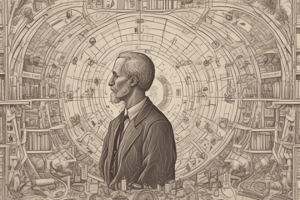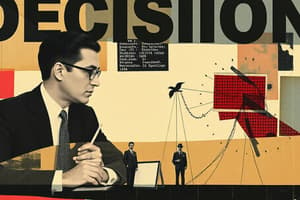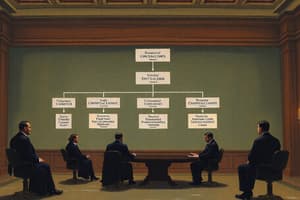Podcast
Questions and Answers
Which of the following statements accurately describes a core assumption of the unitarist view on organizations?
Which of the following statements accurately describes a core assumption of the unitarist view on organizations?
- Employees' goals may sometimes conflict with organizational objectives, but these conflicts are easily managed through negotiation.
- Employees inherently possess goals that align with and support the goals of the organization and their colleagues. (correct)
- Employees' actions are fundamentally influenced by external political factors, overshadowing their commitment to organizational goals.
- Employees' actions are primarily driven by personal ambitions that are often misaligned with organizational goals.
Why is the unitarist perspective considered problematic when analyzing organizational dynamics?
Why is the unitarist perspective considered problematic when analyzing organizational dynamics?
- It prioritizes external stakeholder interests over internal operational needs.
- It assumes that all employees are inherently motivated to undermine managerial decisions.
- It fails to adequately recognize the presence and impact of power dynamics and political behaviors within the organization. (correct)
- It overemphasizes the role of employee empowerment, leading to organizational inefficiencies.
According to the pluralist perspective, how should the diverse interests within an organization be addressed?
According to the pluralist perspective, how should the diverse interests within an organization be addressed?
- By suppressing conflicting viewpoints to maintain a unified organizational culture.
- By disregarding minority interests in favor of decisions that benefit the majority of employees.
- By strictly enforcing a hierarchical structure to ensure that managerial directives are uniformly followed.
- By acknowledging and integrating these interests through negotiation and participation in decision-making processes. (correct)
What is the central idea behind the pluralist view of organizations?
What is the central idea behind the pluralist view of organizations?
What is the expected outcome when employees are given a voice in decision-making, according to the pluralist perspective?
What is the expected outcome when employees are given a voice in decision-making, according to the pluralist perspective?
According to the pluralist view, what is the nature of conflict within organizations?
According to the pluralist view, what is the nature of conflict within organizations?
What is a key criticism of the pluralist perspective on organizational power dynamics?
What is a key criticism of the pluralist perspective on organizational power dynamics?
What does the term 'pseudo-participation' refer to in the context of the pluralist view?
What does the term 'pseudo-participation' refer to in the context of the pluralist view?
Which perspective best describes how everyday acts of defiance by ordinary people challenge an apparently all-powerful state, like the Nazi regime, by disrupting its pervasive influence?
Which perspective best describes how everyday acts of defiance by ordinary people challenge an apparently all-powerful state, like the Nazi regime, by disrupting its pervasive influence?
In the context of organizational culture, how might the concept of 'organizational hypocrisy', where espoused values differ from actual practices, relate to resistance during the Nazi regime?
In the context of organizational culture, how might the concept of 'organizational hypocrisy', where espoused values differ from actual practices, relate to resistance during the Nazi regime?
Considering Foucault's concept of power/knowledge, how did the Nazi regime maintain control, and how could resistance emerge from this dynamic?
Considering Foucault's concept of power/knowledge, how did the Nazi regime maintain control, and how could resistance emerge from this dynamic?
How might Marx's theory of alienation apply to understanding resistance within Nazi Germany?
How might Marx's theory of alienation apply to understanding resistance within Nazi Germany?
In what way can Morgan's 'Images of Organization' help us see resistance against the Nazi regime?
In what way can Morgan's 'Images of Organization' help us see resistance against the Nazi regime?
Considering Lukes’s 'Radical View of Power', how does the Nazi regime's power operate, and what are the implications for resistance?
Considering Lukes’s 'Radical View of Power', how does the Nazi regime's power operate, and what are the implications for resistance?
If safety culture is defined as the product of individual and group values, attitudes, perceptions, competencies, and patterns of behavior that determine the commitment to, and the style and proficiency of, an organization’s health and safety management, how might that concept explain resistance during the Nazi regime?
If safety culture is defined as the product of individual and group values, attitudes, perceptions, competencies, and patterns of behavior that determine the commitment to, and the style and proficiency of, an organization’s health and safety management, how might that concept explain resistance during the Nazi regime?
How could Brunsson's concept of organizational hypocrisy explain the emergence of resistance movements within Nazi Germany?
How could Brunsson's concept of organizational hypocrisy explain the emergence of resistance movements within Nazi Germany?
According to Jackson and Carter (2000), what is 'normalisation' in the context of governance?
According to Jackson and Carter (2000), what is 'normalisation' in the context of governance?
What is the radical perspective on employee resistance within a capitalist system?
What is the radical perspective on employee resistance within a capitalist system?
Foucault's quote, 'Where there is power, there is resistance,' suggests what about the relationship between power and resistance?
Foucault's quote, 'Where there is power, there is resistance,' suggests what about the relationship between power and resistance?
According to the relational view of power, how is power understood in social relationships?
According to the relational view of power, how is power understood in social relationships?
How does the unitarist perspective view conflict and resistance in organizations?
How does the unitarist perspective view conflict and resistance in organizations?
What is a key limitation of the pluralist view of conflict and resistance?
What is a key limitation of the pluralist view of conflict and resistance?
How does the radical perspective understand 'false consciousness' in the context of power and resistance?
How does the radical perspective understand 'false consciousness' in the context of power and resistance?
If analyzing a film about power struggles using unitarist, pluralist, and radical perspectives, what would be a key focus of the radical perspective?
If analyzing a film about power struggles using unitarist, pluralist, and radical perspectives, what would be a key focus of the radical perspective?
According to Lukes's framework, what is a key characteristic of the 'second face of power'?
According to Lukes's framework, what is a key characteristic of the 'second face of power'?
Brunsson's observation that 'talk, decisions, and actions are not necessarily aligned' relates most closely to which aspect of organizational power dynamics?
Brunsson's observation that 'talk, decisions, and actions are not necessarily aligned' relates most closely to which aspect of organizational power dynamics?
What is the central critique of pluralist accounts of organizational power offered by the radical view?
What is the central critique of pluralist accounts of organizational power offered by the radical view?
The concept of organizations as 'deeply imbedded sites of domination' suggests that:
The concept of organizations as 'deeply imbedded sites of domination' suggests that:
According to the radical view, maintaining the 'managerial status quo' in organizations primarily serves to:
According to the radical view, maintaining the 'managerial status quo' in organizations primarily serves to:
What does the 'invisible hand of power' refer to within organizations?
What does the 'invisible hand of power' refer to within organizations?
According to Lukes's framework, what characterizes the 'third face of power'?
According to Lukes's framework, what characterizes the 'third face of power'?
How does Foucault's concept of the Panopticon relate to the radical view of power in organizations?
How does Foucault's concept of the Panopticon relate to the radical view of power in organizations?
What is a key implication of the statement that 'power is embedded in all social relations'?
What is a key implication of the statement that 'power is embedded in all social relations'?
Which of the following best describes the relationship between the 'radical view' of organizational power and employee resistance?
Which of the following best describes the relationship between the 'radical view' of organizational power and employee resistance?
Flashcards
Unitarist View
Unitarist View
The belief that employees share common goals and work harmoniously towards them.
Problem with the Unitarist View
Problem with the Unitarist View
Failing to recognize the role of power and political dynamics in organizations.
Pluralist View
Pluralist View
An organization is seen as a collection of diverse groups with varying interests.
Acceptance in Pluralism
Acceptance in Pluralism
Signup and view all the flashcards
Pluralism and Decision-Making
Pluralism and Decision-Making
Signup and view all the flashcards
Pluralism and Conflict
Pluralism and Conflict
Signup and view all the flashcards
Issues with Pluralism
Issues with Pluralism
Signup and view all the flashcards
Sanctioned Resistance
Sanctioned Resistance
Signup and view all the flashcards
Non-decision-making
Non-decision-making
Signup and view all the flashcards
Misaligned Actions
Misaligned Actions
Signup and view all the flashcards
Agenda Setting
Agenda Setting
Signup and view all the flashcards
Organizations as Domination
Organizations as Domination
Signup and view all the flashcards
Defining Social Reality
Defining Social Reality
Signup and view all the flashcards
Serving Managerial Interests
Serving Managerial Interests
Signup and view all the flashcards
Shaping Desires and Beliefs
Shaping Desires and Beliefs
Signup and view all the flashcards
False Consciousness
False Consciousness
Signup and view all the flashcards
3rd Face of Power
3rd Face of Power
Signup and view all the flashcards
Panopticon Effect
Panopticon Effect
Signup and view all the flashcards
Normalisation
Normalisation
Signup and view all the flashcards
Radical View on Conflict
Radical View on Conflict
Signup and view all the flashcards
Foucault's Quote on Power
Foucault's Quote on Power
Signup and view all the flashcards
Relational View on Power
Relational View on Power
Signup and view all the flashcards
Unitarist View of Power
Unitarist View of Power
Signup and view all the flashcards
Pluralist View of Power
Pluralist View of Power
Signup and view all the flashcards
Radical View of Power
Radical View of Power
Signup and view all the flashcards
Radical View
Radical View
Signup and view all the flashcards
Dispersed Power
Dispersed Power
Signup and view all the flashcards
Embedded Power
Embedded Power
Signup and view all the flashcards
Resistance
Resistance
Signup and view all the flashcards
Power of Ordinary People
Power of Ordinary People
Signup and view all the flashcards
Power
Power
Signup and view all the flashcards
Organisational Hypocrisy
Organisational Hypocrisy
Signup and view all the flashcards
Problems with Pluralism
Problems with Pluralism
Signup and view all the flashcards
Study Notes
- Unitarist view assumes employees' goals conform to and are compatible with those around them and that employees' actions are directed towards achieving these goals.
- The unitarist view is problematic because it fails to acknowledge power and politics and focuses only on managerial prerogative.
- Pluralist and radical views on power and politics take on a more complex perspective.
Pluralism
- The organization is a living organism, made up of various sub-systems.
- Emphasis is placed on the diversity of individual/group interests; the organization is a loose coalition with a passing interest in formal goals
- An acceptance of competing interests and politics is observed.
- Employees are given a place and voice in decision-making.
- The aim is for a "negotiated order that creates unity out of diversity" (Morgan, 2006).
- Conflict is inevitable, legitimate, manageable, and resolvable.
- Pluralism tends to assume a balance of power exists between parties with different interests (Burrell and Morgan, 1979).
- Pluralism aims to provide a more realistic outlook by acknowledging that power and politics have a place.
- Pluralism assumes that all parties are rational, work with a common interest, and are willing to trust and compromise.
- Pluralism also assumes that all conflict is manageable and resolvable.
- Only 'sanctioned' forms of resistance and conflict are acceptable within pluralism.
- An equal balance of power exists rarely.
- When pluralists refer to participation, it is often pseudo-participation.
- Lukes (1974) notes that management still has overriding power and can control the agenda through 'non-decision-making, including what items are unacceptable to address.
- Talk, decisions, and actions are not always aligned (Brunsson, 2002).
- Participation can be limited to unimportant issues, while more important issues can be removed from the agenda to keep potential conflicts off.
- Power can set conditions and keep issues on or off the agenda.
Radical View
- Organisations are instruments of domination.
- A critique of pluralist accounts suggests that the assumption of organizations as level playing fields is, at best, optimistic.
- Organisations are deeply imbedded sites of domination.
- Less powerful groups are constantly outflanked by dominant managerial groups and the power to define social reality and conceal conflicts of power (Alvesson, 100 Fulop, and Linstead, 20).
- Power in organizations is seen as an exercise in maintaining the status quo of managerial control, directing employees to "deliver capital accumulation (Willmott, 1993: 519) and serving the means of privileged (Fulop and Linstead, 2004; Clegg and Dunkerley, 1980: 197-8).
- Managers create a culture shaping employee’s desires and beliefs, so conflicts of interest are obscured, and resistance is “eliminated, or never created first (Antonsen, 2007:186).
- Employees do not realize:
- No alternative to managers
- What managers do is beneficial
- Control and conformity are achieved through surveillance – The Panopticon & disciplinary power (Foucault, 1979).
- Power is embedded in all social relations, and all situations inhabited.
- Normalisation: “people accept as normal the expectations of those who govern them and comply with them" (Jackson and Carter, 2000: 105).
- Self-disciplining is the result.
- Radical views and accounts do not see employee resistance as irrational, pathological, and dysfunctional (Knights and Willmott, 2017).
- As long as we are working within a capitalist system, exploitation, asymmetrical power relationships, dehumanisation, oppression and resistance will continue to occur.
- Different forms of power give way to different forms of resistance.
- As control increases, "so too does [employee] resistance to the domination of capital, and with it, the necessity for capital to overcome this resistance by counter pressure".
Relational View
- Power is a relationship; it occurs 'a condition of social relations in the sense we are all capable of exercising power’ (McCabe, 2007: 228).
- Power is embedded in all social relationships between free people. Thus, everyone has power through the relationship, which may have built-in power inequalities.
Views of Power: Recap
- Unitarist:
- Power is united in the hands of management.
- Conflict or resistance is dysfunctional.
- Misses the fact that there is a naïve expectation of conformity.
- Pluralist:
- Diffused in coalitions.
- Overt, manageable, and resolvable.
- Misses that fact that there are power differentials between different groups and that power lies in the power of setting the agenada
- Radical:
- Believes Power is invisible.
- Conflict or resistance is inescapable.
- It hides real issues (false consciousness), misses the fact that false consciousness is questionable.
Studying That Suits You
Use AI to generate personalized quizzes and flashcards to suit your learning preferences.




